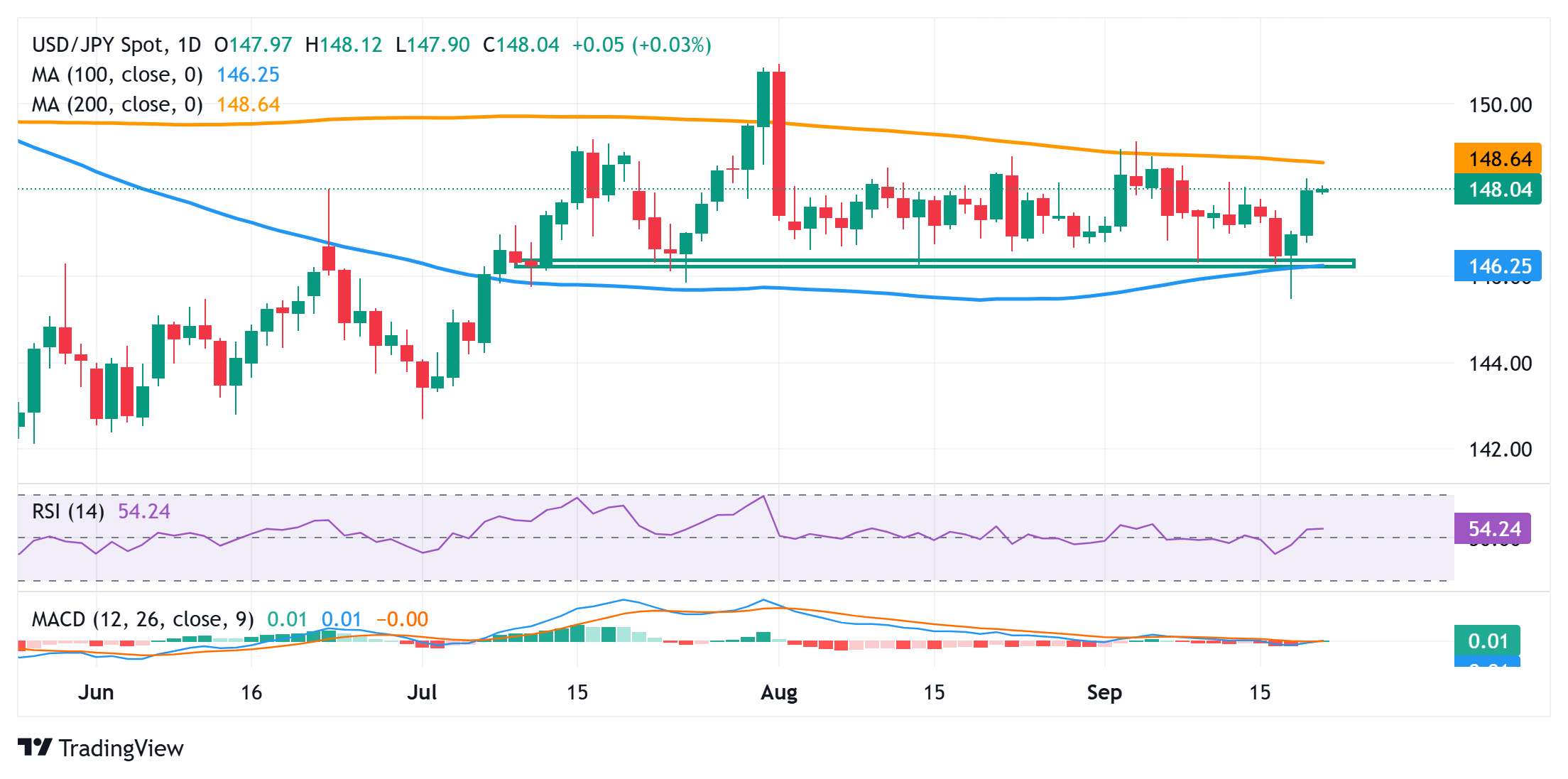Japanese Yen reacts little to National CPI report as traders await BoJ decision
- The Japanese Yen languishes near its lowest level in more than one week against a firmer USD.
- The uncertainty over the likely timing and the pace of the BoJ rate hike undermines the JPY.
- A hawkish assessment of Fed Chair Powell’s comments supports the USD and the USD/JPY pair.
The Japanese Yen (JPY) remains on the back foot after data released during the Asian session on Friday showed that Japan's core consumer prices rose at the slowest pace in nine months during August. This comes on top of domestic political uncertainty and gives the Bank of Japan (BoJ) more reasons to delay interest rate hikes. Apart from this, the underlying bullish sentiment – as depicted by a generally positive tone around the equity markets – turns out to be another factor undermining the safe-haven JPY.
The JPY bears, however, seem reluctant to place aggressive bets and opt to wait for the outcome of a two-day BoJ policy meeting. In the meantime, the US Dollar (USD) is looking to build on the sharp post-FOMC recovery from its lowest level since February 2022 and is acting as a tailwind for the USD/JPY pair, which touched a one-and-a-half-week high on Thursday. That said, bets that the BoJ will stick to its policy normalization path and the prospects for more rate cuts by the Fed could cap gains for the major.
Japanese Yen traders opt to move to the sidelines ahead of the pivotal BoJ policy update
- The Ministry of Internal Affairs and Communications reported this Friday that Japan's consumer prices excluding fresh food rose 2.7% in the year to August. This marks a notable deceleration from a 3.1% increase recorded the previous month and the slowest pace since November 2024.
- Further details of the report revealed that the core Consumer Price Index (CPI), which excludes fresh food, slowed from a 3.1% year-on-year rise seen in July to 2.7%. Moreover, a gauge stripping away both volatile and fresh food and fuel costs rose 3.3% compared to a 3.4% increase in July.
- Meanwhile, the data is unlikely to change the Bank of Japan's decision, scheduled to be announced later today. The central bank is expected to leave policy rates unchanged at the end of a two-day meeting amid domestic political uncertainty and economic headwinds stemming from US tariffs.
- Investors, however, are still pricing in the possibility of a 25-basis-point BoJ rate hike in October amid signs of economic resilience. Hence, the focus will be on the accompanying policy statement and BoJ Governor Kazuo Ueda’s forward guidance at the post-meeting press conference.
- A hawkish assessment of Federal Reserve Chair Jerome Powell's comments on Wednesday assists the US Dollar to preserve its strong recovery gains registered over the past two days, from the lowest level since February 2022. This, in turn, keeps the USD/JPY pair close to the weekly high.
- Powell told reporters that risks to inflation are tilted to the upside and the move to lower interest rates was a risk management cut. Powell added that he doesn't feel the need to move quickly on rates and that the Fed is in a meeting-by-meeting situation regarding the outlook for interest rates.
- Nevertheless, the US central bank is still expected to deliver two more rate cuts in 2025. This marks a significant divergence in comparison to relatively hawkish BoJ expectations, which could support the lower-yielding JPY and keep a lid on any further appreciation for the USD/JPY pair.
USD/JPY bullish setup backs the case for further gains to the 200-day SMA, around 148.60

The overnight move beyond the 147.50-147.60 horizontal resistance and the 148.00 mark favors the USD/JPY bulls. Moreover, oscillators on the daily chart have just started gaining positive traction and back the case for additional gains. Any subsequent move up, however, is likely to confront stiff resistance near the 200-day Simple Moving Average (SMA), currently pegged near the 148.55-148.60 region. A sustained strength beyond might then allow spot prices to reclaim the 149.00 round figure and test the monthly swing high, around the 149.20 zone.
On the flip side, the 147.60-147.50 area now seems to protect the immediate downside, below which the USD/JPY pair could accelerate the slide towards the 147.00 mark. A convincing break below the latter would expose the 146.20 horizontal support before spot prices extend the downward trajectory towards the 145.50-145.45 region, or the lowest level since July 7, touched earlier this week.
Economic Indicator
National CPI ex Food, Energy (YoY)
Japan’s National Consumer Price Index (CPI), released by the Statistics Bureau of Japan on a monthly basis, measures the price fluctuation of goods and services purchased by households nationwide. The YoY reading compares prices in the reference month to the same month a year earlier. The gauge excluding food and energy is widely used to measure underlying inflation trends as these two components are more volatile. Generally, a high reading is seen as bullish for the Japanese Yen (JPY), while a low reading is seen as bearish.
Read more.Last release: Thu Sep 18, 2025 23:30
Frequency: Monthly
Actual: 3.3%
Consensus: -
Previous: 3.4%
Source: Statistics Bureau of Japan

